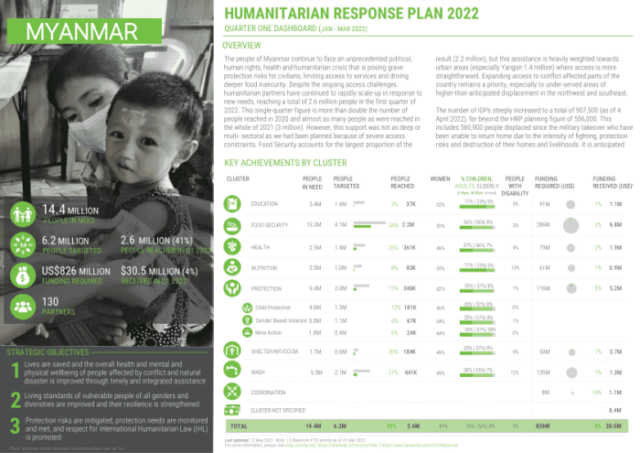Myanmar: Humanitarian Response Plan 2022 – Quarter One Dashboard (Jan – Mar 2022)

OVERVIEW
The people of Myanmar continue to face an unprecedented political, human rights, health and humanitarian crisis that is posing grave protection risks for civilians, limiting access to services and driving deeper food insecurity. Despite the ongoing access challenges, humanitarian partners have continued to rapidly scale-up in response to new needs, reaching a total of 2.6 million people in the first quarter of 2022. This single-quarter figure is more than double the number of people reached in 2020 and almost as many people as were reached in the whole of 2021 (3 million). However, this support was not as deep or multi- sectoral as we had been planned because of severe access constraints. Food Security accounts for the largest proportion of the result (2.2 million), but this assistance is heavily weighted towards urban areas (especially Yangon 1.4 million) where access is more straightforward. Expanding access to conflict-affected parts of the country remains a priority, especially to under-served areas of higher-than-anticipated displacement in the northwest and southeast.
The number of IDPs steeply increased to a total of 907,500 (as of 4 April 2022), far beyond the HRP planning figure of 556,000. This includes 560,900 people displaced since the military takeover who have been unable to return home due to the intensity of fighting, protection risks and destruction of their homes and livelihoods. It is anticipated that most of these additional IDPs were already covered in the HRP under the ‘vulnerable people with humanitarian needs’ population group and this will be reconciled in the mid-year report. Partners have been able to reach 353,000 IDPs with assistance so far in 2022, although coverage in conflict affected areas, particularly in the northwest remains low.
The HRP remains severely underfunded with only 4 per cent of requirements received by the end of Q1 according to FTS. Substantial carry-over funding from 2021 has underwritten many activities in the reporting period, allowing Food Security partners, in particular, to deliver beyond the new funding commitments received this year. Without additional funds in Q2 and beyond, humanitarian partners will have to prioritize lower-cost life-saving and critical activities that do not offer the required depth of relief or contribute to people’s overall well-being, dignified living standards, or chance of finding durable solutions. During Q1, inflation also further eroded coping capacities of people in need, while adding to the cost of delivering services. The international community and a growing network of local organizations stand ready to assist in 2022 but will require increased funding, improved access to affected people, and an end to bureaucratic issues with visas, MOUs and banking.


